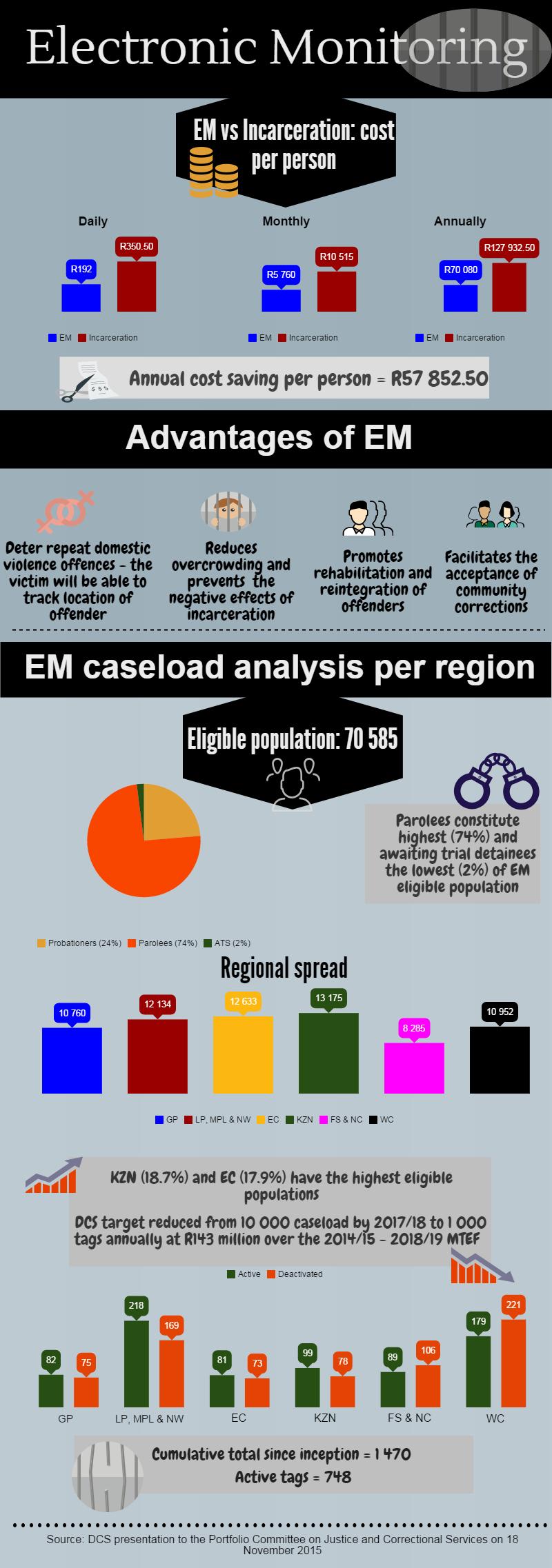On 18 November 2015 the Department of Correctional Services (DCS) in their presentation to the Portfolio Committee on Justice and Correctional Services explained that the electronic monitoring system (EMS)was a way of tracking and recording an offender’s location and movements with a device, usually attached to the ankle, linked to global positioning system satellites, enabling rapid investigation of and response to suspicious movements by the tagged offender. It can be used at every stage of the criminal justice process, i.e. from pre-trial, through primary sentencing to post-sentence stages.
Initially, the department had planned to ramp up the speed of the roll-out each year, so that by 2017/18 10 000 offenders would have been tagged. However, due to insufficient budget allocation (R28m in 2014/15 and R29m in 2015/16), this target had been revised, and it would now aim to add just 1000 more offenders each year. Currently, the regional population eligible for electronic monitoring stands at 70 585 offenders.
Interesting financial facts to consider:
-
The per person cost of incarceration is R350.50 per day, whereas the cost of electronic monitoring amounts to just R192.00 per person. This would amount to annual cost saving of R57 852.50
-
The electronic monitoring pilot project was budget through the reprioritisation of the DCS allocation
-
For the roll out of the electronic monitoring system (EMS) on 1 July 2014, the budget for 2014/15 was R28 million and 29 million for 2015/16
-
Due to insufficient budget allocation, DCS reduced the number of tags from 10 000 by 2017/18 to just 1 000 tags to be added annually over the 2014/15 - 2018/19 MTEF
Although the tagging of offenders did not physically restrain them from committing a crime, the electronic monitoring control room identifies and manages alerts and violations triggered by EMS. Offenders are monitored 24 hours a day and the Department urged the Committee to consider allocating more funding to EMS. The electronic monitoring device has its own psychological effects on offenders, but the Department was confident that the advantages far outweighed the disadvantages. These advantages include reducing overcrowding in correctional centres and preventing the negative psychological effects of incarceration, especially for first time offenders. It also promotes the rehabilitation and reintegration of offenders and it facilitates the acceptance of community corrections system as credible and reliable. It could also deter offenders from repeating domestic violence, because victims will be issued with a device to trak their locations.
Members however were widely concerned about the ongoing problems with ICT infrastructure which was identified as an ongoing challenge faced by the Department. They questioned why the department needed more money for the programme if it was saving money and they also enquired into technical matters such as signal coverage, charging the tracking devices, durability and they also wanted clarity on how the system would be used in practice in the criminal justice process.
See infographic below for more details on electronic monitoring:



Comments
Keep comments free of racism, sexism, homophobia and abusive language. People's Assembly reserves the right to delete and edit comments
(For newest comments first please choose 'Newest' from the 'Sort by' dropdown below.)